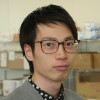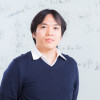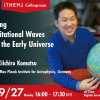141 events in 2021
-
Seminar
Wave function geometry and anomalous Landau levels of flat bands
October 7 (Thu) at 16:00 - 17:15, 2021
Bohm-Jung Yang (Associate Professor, Department of Physics and Astronomy, Seoul National University, Republic of Korea)
Semiclassical quantization of electronic states under magnetic field describes not only the Landau level spectrum but also the geometric responses of metals under a magnetic field. However, it is unclear whether this semiclassical idea is valid in dispersionless flat-band systems, in which an infinite number of degenerate semiclassical orbits are allowed. In this talk, I am going to show that the semiclassical quantization rule breaks down for a class of flat bands including singular flat bands [1-5] and isolated flat bands [6]. The Landau levels of such a flat band develop in the empty region in which no electronic states exist in the absence of a magnetic field. The total energy spread of the Landau levels of flat bands is determined by the quantum geometry of the relevant Bloch states, which is characterized by their Hilbert–Schmidt quantum distance and fidelity tensors. The results indicate that flat band systems are promising platforms for the direct measurement of the quantum geometry of wavefunctions in condensed matter. *Detailed information about the seminar refer to the email.
Venue: via Zoom
Event Official Language: English
-
Seminar

Speed limit for population dynamics
October 7 (Thu) at 10:00 - 11:00, 2021
Kyosuke Adachi (Special Postdoctoral Researcher, Nonequilibrium Physics of Living Matter RIKEN Hakubi Research Team, RIKEN Center for Biosystems Dynamics Research (BDR))
In statistical and quantum physics, the speed limit, i.e., upper bound for change rate, of time-dependent quantities has been discussed. In this talk, I will extend the concept of speed limit to ecological and evolutionary processes by considering the competitive Lotka-Volterra model and the quasi-species model. As an application of the speed limit, I will also discuss the universal constraint for the relaxation at the bifurcation point of such models.
Venue: via Zoom
Event Official Language: English
-
Seminar
Donaldson-Thomas invariants, wall-crossing and categorifications
October 1 (Fri) at 16:00 - 18:10, 2021
Yukinobu Toda (Professor, Kavli Institute for the Physics and Mathematics of the Universe (Kavli IPMU), The University of Tokyo)
It is an important subject to study algebraic curves inside algebraic varieties, both in classical algebraic geometry and also enumerative geometry inspired by string theory. The Donaldson-Thomas theory is one of curve counting theories on Calabi-Yau 3-folds, and has developed in these 20 years from several aspects of mathematics and mathematical physics. Among them, the wall-crossing in derived category turned out to be a key phenomena in proving deep structures of generating series of Donaldson-Thomas invariants. In the first one hour, I will review the classical aspect of counting curves inside algebraic varieties, and explain how it leads to modern enumerative geometry such as Gromov-Witten invariants, Donaldson-Thomas invariants. In the second one hour, I will explain wall-crossing phenomena in Donaldson-Thomas theory, and its categorification in the case of the resolved conifold. *Please contact Keita Mikami's mail address to get access to the Zoom meeting room.
Venue: via Zoom
Event Official Language: English
-
Seminar

Evolutionary dynamics of seasonal influenza viruses
September 30 (Thu) at 10:00 - 11:00, 2021
Takashi Okada (Senior Research Scientist, RIKEN Interdisciplinary Theoretical and Mathematical Sciences Program (iTHEMS))
Seasonal influenza viruses undergo rapid evolution, which allows them to escape from human-immune-system responses and infect humans repeatedly. In this talk, I present some counter-intuitive properties observed in time-series data of viral sequence variation and then discuss how these strange properties can be explained by extending the standard framework of population genetics.
Venue: via Zoom
Event Official Language: English
-
Colloquium

Finding Gravitational Waves from the Early Universe
September 27 (Mon) at 16:00 - 17:30, 2021
Eiichiro Komatsu (Director, Max Planck Institute for Astrophysics, Germany)
The Cosmic Microwave Background (CMB) gives a photographic image of the Universe when it was still an “infant”. We have been using it to test our ideas about the origin of the Universe. The CMB research told us a remarkable story: the structure we see in our Universe such as galaxies, stars, planets, and eventually ourselves originated from tiny quantum fluctuations in the period of the early Universe called cosmic inflation. While we have accumulated strong evidence for this picture, the extraordinary claim requires extraordinary evidence. The last prediction of inflation that is yet to be confirmed is the existence of primordial gravitational waves whose wavelength can be as big as billions of light years. To this end we have proposed to JAXA a new satellite mission called LiteBIRD, whose primary scientific goal is to find signatures of gravitational waves in the polarisation of the CMB. In this presentation we describe physics of gravitational waves from inflation, and the LiteBIRD proposal.
Venue: via Zoom
Event Official Language: English
-
Seminar
High-harmonic generation in strongly correlated systems
September 15 (Wed) at 13:30 - 15:00, 2021
Yuta Murakami (Assistant Professor, School of Science, Tokyo Institute of Technology)
High-harmonic generation (HHG) is an intriguing nonlinear phenomenon induced by a strong electric field. It has been originally observed and studied in atomic and molecular gases, and is used in attosecond laser sources as well as spectroscopies. An observation of HHG in semiconductors expanded the scope of this field to condensed matters [1]. The HHG in condensed matters is attracting interests since it may be used as new laser sources and/or as powerful tools to detect band information such as the Berry curvatures. Recently, further exploration of the HHG in condensed matters are carried out in various other systems than semiconductors. In this talk, we introduce our recent theoretical efforts on the HHG in strongly correlated systems [2,3,4]. In contract to semiconductors, the charge carriers are not normal fermions, which makes HHG in strongly correlated systems unclear. Using the dynamical-mean field theory and the infinite time-evolving block decimation for the Hubbard model, we reveal the HHG features in the Mott insulators. Firstly, we reveal that the origin of the HHG in the Mott insulator is the recombination of doublons (doubly occupied sites) and holons (no electron site). Then, we show that the HHG feature qualitatively changes depending on the field strength due to the change of mobility of charge carriers, and discuss that the HHG directly reflects the dynamics of many body elemental excitations, which the single particle spectrum may miss. These results indicate that the HHG in Mott systems may be used as a spectroscopic tool for many body excitations. We also discuss the effects of spin dynamics on the HHG, which is a unique feature in strongly correlated systems.
Venue: via Zoom
Event Official Language: English
-
Seminar
S-matrix Unitarity toward UV Completion
September 13 (Mon) at 13:30 - 15:00, 2021
Keisuke Izumi (Assistant Professor, Kobayashi-Maskawa Institute for the Origin of Particles and the Universe (KMI), Nagoya University)
Einstein gravity is not renormalizable and does not hold perturbative unitarity at high energy. This is the main reason why the construction of quantum gravity is difficult. A conjecture was proposed by Llewellyn Smith, "renormalizablility and tree-unitarity at high energy give the same conditions for theories". This conjecture would be important because it shows that, if a theory is constructed s.t. unitarity is satisfied, renormalizablility holds automatically, and vice versa. Unfortunately, a counterexample was pointed out. If a theory involves higher derivatives, there exists a theory which is renormalizable but does not satisfy tree-unitarity. A candidate of quantum gravity, the quadratic gravity (R_{\mu\nu}^2 gravity), is one of the examples. Therefore, Llewellyn Smith's conjecture would not be useful for the discussion of quantum gravity. Then, we introduce a new conjecture, "renormalizablility and S-matrix unitarity (or often called pseudo-unitarity) at high energy give the same conditions for theories". In this talk, Llewellyn Smith's conjecture and our contribution to it will be explained. Then, our new conjecture will be introduced. Finally, it will be shown that our conjecture works well even in theories with higher derivatives.
Venue: via Zoom
Event Official Language: English
-
Seminar
Towards a description of amorphous solids and viscoelastic materials using effective field theory and holographic methods
September 10 (Fri) at 13:30 - 15:00, 2021
Matteo Baggioli (Associate Professor, School of Physics and Astronomy, Shanghai Jiao Tong University, China)
Among the most ubiquitous phases of matter, gases and crystalline solids are definitely the simplest to be described. Their physics is indeed almost entirely textbooks material and it can be summarized within the elegant frameworks of kinetic theory and Debye theory. Liquids and specially viscoelastic systems and amorphous materials (e.g. glasses) exhibit a much richer and complex dynamics with provides a large set of fundamental and unresolved physical questions. Given the tremendous microscopic complexity of these systems, which is manifest in a large landscape of scales and anomalous behaviours, the effective field theory (EFT) paradigm of isolating only a few, but fundamental, information could provide a winning approach. This talk is based on the simple, but indeed extremely difficult, question of whether these phases of matter can be distinguished, classified and understood using emergent and/or fundamental symmetry principles as in their ordered crystal counterpart. More precisely, we will combine EFTs, hydrodynamics and holographic methods to tackle the above question. I will present the most recent developments in this direction and I will discuss with you the most important open questions and avenues to explore in the near future.
Venue: via Zoom
Event Official Language: English
-
Seminar

How to make a dataset for phylogeny and the background of mathematical theory
September 9 (Thu) at 10:00 - 11:00, 2021
Euki Yazaki (Postdoctoral Researcher, RIKEN Interdisciplinary Theoretical and Mathematical Sciences Program (iTHEMS))
Molecular phylogenetic analysis is a very important method of analysis for understanding the evolution of organisms and so on. The method of molecular phylogenetic analysis itself is often discussed, and you are probably familiar with the background of the analysis. The dataset to be analyzed is just as important as the analysis method. However, it is not well known how the data set is made and what the methodology behind it is. Therefore, I will outline the background to the creation of data sets.
Venue: via Zoom
Event Official Language: English
-
Seminar
The Polarised ring of the Supermassive Black Hole in M87: EHT observations and theoretical modeling
September 3 (Fri) at 14:00 - 16:00, 2021
Yosuke Mizuno (T.D. Lee Fellow / Associate Professor, Tsung-Dao Lee Institute, Shanghai Jiao Tong University, China)
The Event Horizon Telescope has mapped the central compact radio source of the elliptical galaxy M87 at 1.3 mm with unprecedented angular resolution. These images show a prominent ring with a diameter of ~40 micro-arcsecond, consistent with the size and shape of the lensed photon orbit encircling the “shadow” of a supermassive black hole. Recently EHT has provided new images of the polarised emission around the central black hole in M87 on event-horizon scale. This polarised synchrotron emission probes the structure of magnetic fields and the plasma properties near the black hole. We found that the net azimuthal linear polarisation pattern may result from organised, poloidal magnetic fields in the emission region. In a quantitative comparison with a large simulated polarimetric image library, we found that magnetically arrested accretion disks are favoured to explain polarimetric EHT observations. In this talk, I also briefly discuss about a new modelling study of M87 jets in the collimation and acceleration region.
Venue: via Zoom
Event Official Language: English
-
Seminar

Journal Club: A quantitative quasispecies theory-based model of virus escape mutation under immune selection
September 2 (Thu) at 10:00 - 11:00, 2021
Yingying Xu (Special Postdoctoral Researcher, RIKEN Interdisciplinary Theoretical and Mathematical Sciences Program (iTHEMS))
I would like to introduce the paper "a quantitative quasispecies theory-based model of virus escape mutation under immune selection", written by Hyung-June Woo and Jaques Reifman [1]. Paper abstract: Viral infections involve a complex interplay of the immune response and escape mutation of the virus quasispecies inside a single host. Although fundamental aspects of such a balance of mutation and selection pressure have been established by the quasispecies theory decades ago, its implications have largely remained qualitative. Here, we present a quantitative approach to model the virus evolution under cytotoxic T-lymphocyte immune response. The virus quasispecies dynamics are explicitly represented by mutations in the combined sequence space of a set of epitopes within the viral genome. We stochastically simulated the growth of a viral population originating from a single wild-type founder virus and its recognition and clearance by the immune response, as well as the expansion of its genetic diversity. Applied to the immune escape of a simian immunodeficiency virus epitope, model predictions were quantitatively comparable to the experimental data. Within the model parameter space, we found two qualitatively different regimes of infectious disease pathogenesis, each representing alternative fates of the immune response: It can clear the infection in finite time or eventually be overwhelmed by viral growth and escape mutation. The latter regime exhibits the characteristic disease progression pattern of human immunodeficiency virus, while the former is bounded by maximum mutation rates that can be suppressed by the immune response. Our results demonstrate that, by explicitly representing epitope mutations and thus providing a genotype–phenotype map, the quasispecies theory can form the basis of a detailed sequence-specific model of real-world viral pathogens evolving under immune selection. *Please refer to the email to get access to the Zoom meeting room.
Venue: via Zoom
Event Official Language: English
-
Seminar
Extended and interacting bound states in elemental superconductors
September 1 (Wed) at 16:00 - 17:15, 2021
Levente Rózsa (Condensed Matter Physics, University of Konstanz, Germany)
Combining magnetism with superconductivity leads to the emergence of localized states, including Majorana bound states predicted to be relevant for topological quantum computation. In this talk, I discuss how these bound states are influenced by the details of the electronic structure. It will be shown how the shape of the Fermi surface leads to a long-ranged anisotropic extension of Yu-Shiba-Rusinov states in the vicinity of magnetic impurities [1]. The same type of Fermi surface will be demonstrated to give rise to topologically trivial Caroli-de Gennes-Matricon bound states in vortex cores [2], with similar spatial profiles to those of topological Majorana bound states. The role of spin-orbit coupling will be discussed in the hybridization of Yu-Shiba-Rusinov bound states of dimers with ferromagnetic and antiferromagnetic spin alignments [3]. The general theoretical concepts will be illustrated by experimental realizations in specific materials. *Detailed information about the seminar refer to the email.
Venue: via Zoom
Event Official Language: English
-
Seminar

Mathematical analysis of body temperature fluctuation during hibernation
August 26 (Thu) at 10:00 - 11:00, 2021
Gen Kurosawa (Senior Research Scientist, RIKEN Interdisciplinary Theoretical and Mathematical Sciences Program (iTHEMS))
Hibernation (tomin in Japanese) is a strategy for the organisms to survive in a severe season with limited food and water availability. During hibernation, the organisms drastically decrease their basal metabolisms, drop their body temperature (Tb) more than 10 degree, and become immobile. Interestingly, body temperature during hibernation does not remain constant at very low value, but greatly fluctuates with inconstant period of several days. Although there have been many studies about hibernation since the era of Aristotle, fundamental problems of hibernation remain elusive. Recently, we started to investigate Tb data during hibernation by using a method in acoustic engineering for the analysis of irregular time-series such as music. We succeeded in quantifying many individual data, and found that a simple model can reproduce well and forecast Tb data during hibernation. This is the collaboration with Yoshifumi Yamaguchi at Institute of Low Temperature Science, Hokkaido University and Shingo Gibo at iTHEMS.
Venue: via Zoom
Event Official Language: English
-
Workshop
RIKEN-Vancouver Joint Workshop on Quantum Computing
August 24 (Tue) - 25 (Wed), 2021
The main aim of this workshop is that the quantum people in RIKEN (iTHEMS and RQC) and Vancouver (Quantum BC) get together online to discuss scientific activities and explore future collaborations. Program: August 24, 2021 (8:30am - 1:00pm) Tokyo August 23, 2021 (4:30pm - 9:00pm) Vancouver Tetsuo Hatsuda (iTHEMS): Welcome + iTHEMS overview Yasunobu Nakamura (RQC): RQC overview Lukas Chrostowski (UBC): Quantum BC overview Shunji Matsuura (1QBit): Accurate state preparation on noisy quantum devices Olivia Di Matteo (UBC): Operational, gauge-free quantum tomography Yasunobu Nakamura (RQC): Towards superconducting quantum computing Jason Chang (iTHEMS): Improving Schroedinger equation implementations with gray code for adiabatic quantum computers Robert Raussendorf (UBC): Computationally universal phase of quantum matter Akira Furusawa (RQC): Large-scale quantum computing with quantum teleportation August 25, 2021 (8:30am - 1:30pm) Tokyo August 24, 2021 (4:30pm - 9:30am) Vancouver Etsuko Itou (iTHEMS): Digital quantum simulation for screening and confinement in gauge theory with a topological term Joe Salfi (UBC): Engineering long coherence times of spin-orbit qubits in silicon Seiji Yunoki (RQC): Quantum simulations for quantum many-body systems: Variational quantum algorithms and beyond Takumi Doi (iTHEMS): Hybrid quantum annealing via molecular dynamics Drew Potter (UBC): Simulating highly-entangled matter with quantum tensor networks Seigo Tarucha (RQC): High-fidelity quantum gates in silicon quantum computing Organizing Institutes: iTHEMS: RIKEN Interdisciplinary Theoretical and Mathematical Sciences Program RQC: RIKEN Center for Quantum Computing Quantum BC Organizers: Tetsuo Hatsuda (iTHEMS) Yasunobu Nakamura (RQC) Shunji Matsuura (1QBit) Joseph Salfi (UBC) Erika Kawakami (RQC / RIKEN CPR) Neill Lambert (RIKEN CPR)
Venue: via Zoom
Event Official Language: English
-
Seminar
Application of Machine Learning on Many-Body Problems
August 23 (Mon) at 16:00 - 17:15, 2021
Daw-Wei Wang (Professor, Department of Physics, National Tsinghua University, Taiwan)
Time: 4pm ~ 5:15pm (JST); 9am ~ 10:15am (CET); 3pm ~ 4:15pm (Taiwan) In this talk, I will briefly introduce the application of machine learning methods on quantum many-body problems. It includes a self-supervised learning approach to decide the topological phase transition in the systems of ultracold atoms by using Time-of-Flight images only without knowing any priori knowledge [1]. We then develop the Random Sampling Neural Networks for the investigation of quantum many body ground state properties in the strong interacting regime by a model rtained in the weak interacting regime [2]. Finally, we provide an Quantum-Inspired-Recurrent Neural Network, which could give a precise long-time dynamics of a quantum many-body system, even the model is trained in the short-time regime. We hope to show the great possibility to use machine learning as a new tool to investigate the quantum many-body problems. *Detailed information about the seminar refer to the email.
Venue: via Zoom
Event Official Language: English
-
Seminar
The damped circadian oscillator in cyanobacterium: kaiA-less oscillator
August 19 (Thu) at 10:00 - 11:00, 2021
Naohiro Kawamoto (Researcher, Research Center for Solar Energy Chemistry, Osaka University)
Circadian clocks are conserved in almost all organisms and provide fitness advantages to their owners through scheduling biological processes at appropriate time of diurnal cycles. Cyanobacteria possess circadian clock genes named kaiA, kaiB and kaiC. The phosphorylation cycle of KaiC, driven by KaiA and KaiB, is assumed to be a core oscillator in the cyanobacterial clock, and it has been believed that all of the three genes are essential for circadian oscillations since their finding in 1998. However, we found that the kaiA-disrupted strains exhibited a faint damped oscillation. Measuring the bioluminescence rhythms of mutants revealed that the damped oscillation is generated by transcriptional-translational feedback of kaiBC, but not by the phosphorylation cycle of KaiC. In this talk, in addition to the mechanism of the kaiA-less oscillator, I will propose how it can be beneficial for the total circadian system in the cyanobacterium by analyzing the simple model of the two coupled oscillators.
Venue: via Zoom
Event Official Language: English
-
Seminar
Application of AdS/CFT to non-equilibrium phenomena in external electric fields
August 16 (Mon) at 13:00 - 15:00, 2021
Shunichiro Kinoshita (Collaborative Researcher, Faculty of Science and Engineering, Chuo University)
The AdS/CFT correspondence is a useful tool for studying strongly-coupled gauge theories. According to this correspondence, the D3/D7 brane system in string theory is one of the simplest toy model dual to supersymmetric QCD-like gauge theory. In the dual field theory, the mesons, i.e., the quark-antiquark bound states are stable in vacuum when the quark is massive, while the dielectric breakdown occurs by pair production of quark-antiquark under strong electric fields. In this talk, I will review a series of our works of D3/D7 systems and show time-dependent, non-equilibrium phenomena driven by external electric fields such as suddenly increasing or rotating electric fields.
Venue: via Zoom
Event Official Language: English
-
Seminar

From Yang-Mills theory to enumerative geometry on Calabi-Yau 4-folds
August 6 (Fri) at 16:00 - 18:10, 2021
Yalong Cao (Research Scientist, RIKEN Interdisciplinary Theoretical and Mathematical Sciences Program (iTHEMS))
Yang-Mills theory was studied from mathematical perspectives in the 1970s by Atiyah and his collaborators (notably Drinfeld, Hitchin, Singer). Subsequent breakthroughs were made on dimensions 3 and 4 by Floer and Donaldson (based on deep analytic results obtained by Uhlenbeck and Taubes) in the 1980s. In 1996, Donaldson and Thomas proposed to study Yang-Mills theories on dimensions bigger than 4. In higher dimensions, the analytic method is limited and algebro-geometric method is heavily used instead. This powerful tool usually enables us to compute partition functions and lead to amazing links to other invariants in enumerative geometry, e.g. Gromov-Witten and Gopakumar-Vafa invariants. In this talk, I will review some of these inspiring stories and discuss how my works on Calabi-Yau 4-folds fit into them.
Venue: via Zoom
Event Official Language: English
-
Seminar
Rational design of autonomous, peptide-based ion channels
August 5 (Thu) at 10:00 - 11:00, 2021
Ai Niitsu (Special Postdoctoral Researcher, Theoretical Molecular Science Laboratory, RIKEN Cluster for Pioneering Research (CPR))
Designing artificial ion channel proteins has been a major challenge since rational design of membrane proteins is still in its infancy. To address this challenge, we aim to understand the most fundamental interaction in membrane proteins, helix-helix packing, using artificial peptides. Here, we rationally design, synthesise and characterise transmembrane peptides which self-assemble into stable channels. In this talk, I will present our computational de novo peptide design, structure modelling and molecular dynamics simulations, followed by biophysical experiments indicating structure and function of the designed channels. These works shed light on a sequence-to-structure/stoichiometry of membrane alpha-helices, which will aid more accurate membrane protein designs in future. *Please refer to the email to get access to the Zoom meeting room.
Venue: via Zoom
Event Official Language: English
-
Seminar
Quantum annealing and its fundamental aspects/ Quantum annealing and its application to real world
August 4 (Wed) at 13:30 - 16:00, 2021
Masayuki Ohzeki (Professor, Graduate School of Information Sciences, Tohoku University / Professor, Institute of Innovative Research, Tokyo Institute of Technology / Founder, Leader, Sigma-i Co., Ltd.)
Talk A (13:30~14:30) Title: Quantum annealing and its fundamental aspects Abstract: We introduce a heuristic solver for combinatorial optimization problem, quantum annealing. The quantum annealing utilizes the quantum tunneling effect to search the ground state. In particular, the Ising model with the transverse field is employed for demonstration of the quantum annealing. Most of the combinatorial optimization problem can be described by the Ising model and they are solved by quantum annealing. A decade ago, the D-Wave systems Inc. succeeded in realizing the quantum annealing in their manufactured spin system. In this talk, the concept of quantum annealing and its implementation in the D-Wave quantum annealer are introduced. Talk B (14:40~15:40) Title: Quantum annealing and its application to real world Abstract: In this talk, we review the fundamental aspects of quantum annealing and show several applications to practical combinatorial optimization problems. In particular, in Japan, many researchers in industry are interested in practical applications of quantum annealing. We, Tohoku University, are performing various collaboration with many companies in Japan. The first example is to control automated guided vehicles in collaboration with DENSO. The second one is to list hotel recommendation on a web site with Recruit lifestyle. Other ones are also exhibited as far as possible. Let us discuss a future perspective of the quantum annealing in practical applications.
Venue: via Zoom
Event Official Language: English
141 events in 2021
Events
Categories
series
- iTHEMS Colloquium
- MACS Colloquium
- iTHEMS Seminar
- iTHEMS Math Seminar
- DMWG Seminar
- iTHEMS Biology Seminar
- iTHEMS Theoretical Physics Seminar
- Information Theory SG Seminar
- Quantum Matter Seminar
- ABBL-iTHEMS Joint Astro Seminar
- Math-Phys Seminar
- Quantum Gravity Gatherings
- RIKEN Quantum Seminar
- Quantum Computation SG Seminar
- Asymptotics in Astrophysics SG Seminar
- GW-EOS WG Seminar
- DEEP-IN Seminar
- NEW WG Seminar
- Lab-Theory Standing Talks
- QFT-core Seminar
- STAMP Seminar
- QuCoIn Seminar
- Number Theory Seminar
- Academic-Industrial Innovation Lecture
- Berkeley-iTHEMS Seminar
- iTHEMS-RNC Meson Science Lab. Joint Seminar
- RIKEN Quantum Lecture
- Theory of Operator Algebras
- iTHEMS Intensive Course-Evolution of Cooperation
- Introduction to Public-Key Cryptography
- Knot Theory
- iTHES Theoretical Science Colloquium
- SUURI-COOL Seminar
- iTHES Seminar
